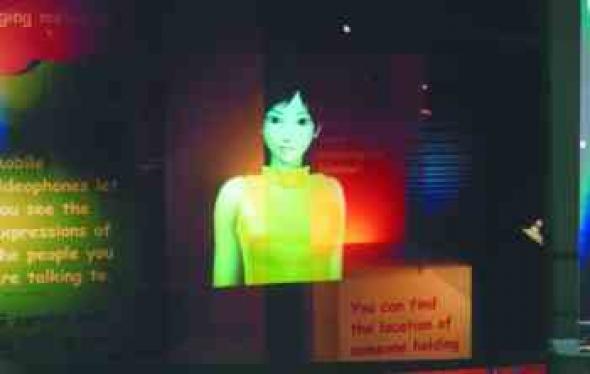Trade Show Science
Japan – Gateway to the Future, one of the Science Museum’s most successful shows in ages, strayed far from its conventional exhibition formula. But what, asks Ian Morrison, did this brash new approach have to do with the museum itself?
In 1998 a Science Museum team travelled across Japan proudly demonstrating British technology. Stephenson’s Rocket, the Boardman Olympic ‘Superbike’, and the DNA model were presented in Kobe, Kitakyushu and Tokyo. In February, in a reciprocal gesture, the Japanese landed in South Kensington, and for six weeks showed some of their latest wares. Enter a world of projectors, orange fleeces, and anime ladies eight feet high.
After exploring this unashamed showcase of hi-tech commodities, I spoke to project director Doran Swade: ‘It’s like a Bladerunner scene: a futuristic, massively intense, brash, ultimate consumer market for electronic goods. The original idea was to recreate electric city. You could walk into the Science Museum and be in Tokyo without having to go there.’ Deadlines and a shaky Japanese economy have taken their toll however; the finished exhibition was more like Olympia than Chiba.
Third Generation phones dominated the entrance and a giant arrow led you to the translucent form of Kay, a computer-generated babe with high boots and big breasts. Using a touch screen, you could reply to her excited and friendly questions. Get all the answers right, and she’d proclaim you a doctor of mobile telephony. I imagined her in Tekken, and moved around the corner.
A big white car contained a shockwave-style driving support system. You could check your email, fuel usage, download secure music from your favourite e-tailer and play it on your Blaupunkt. A girl by the car explained that one day all cars will carry this system. I asked her if that was good for humanity. She didn’t know.
As it turns out, the Science Museum had only minimum involvement in the content. To all intents and purposes, the exhibition was the result of the Japanese External Trade Organisation – JETRO, for short. They chose the companies who, in turn, chose which products would be shown. It makes sense; as Kay explained, she’s ‘on a mission to let as many children in England know about mobile phones!’ [sic]
‘The Japanese do not have a model of technology exhibitions that are not trade shows. Their whole conception of what an exhibition is is modelled on a trade show,’ Swade later remarked. ‘This was a cultural thing – what kind of culture surrounds technology in Japan? There are implicit messages in the fact that, yes, they see this as promotion; this is to do with selling, this is to do with consumerism, these are products intended for the public, and the way we sell them is by having pleasant people here to tell you about them.’
Around the next corner, I see the Sony stage. The museum’s charter prevents them from using the Sony logo on the stand, so they settle for the purple and grey ‘Go Create’ livery. Nevertheless, children are invited to design their own ‘Memory Sticktm Network’, getting their picture taken, manipulated on a Vaiotm, and printed on a Sony printer.
‘It’s fulfiling a traditional mandate of the institution,’ Swade insists. ‘When it was founded after the Great Exhibition of 1851, it was intended to present the public with the best examples of technology. This was much closer to a trade show than any exhibition the Science Museum would put on.’
The AIBOs (robot dogs) dance and play against a video backdrop showing other robots doing yoga. A pretty girl commands: ‘AIBO, karate chop,’ and I wonder if I’d like to fight the robot of the future. PARO the robo-seal purrs softly. It’s therapeutic, they say, but to me it’s just another Teddy Ruxpin (the cheesy robot bear).
So how would a visitor know that this festival of cyber-consumerism wasn’t really the Science Museum? Swade replies with a question of his own:
‘Can one actually do anything to make the Museum transparent as a conduit and platform... and if the answer is no, we must question how we make those messages more explicit, and whether we would do this again.’
Ian Morrison <ian AT darq.net> is a security analyst, and founder of Darq Ltd., a security consultancy in London [http://darq.com/]
Mute Books Orders
For Mute Books distribution contact Anagram Books
contact@anagrambooks.com
For online purchases visit anagrambooks.com








